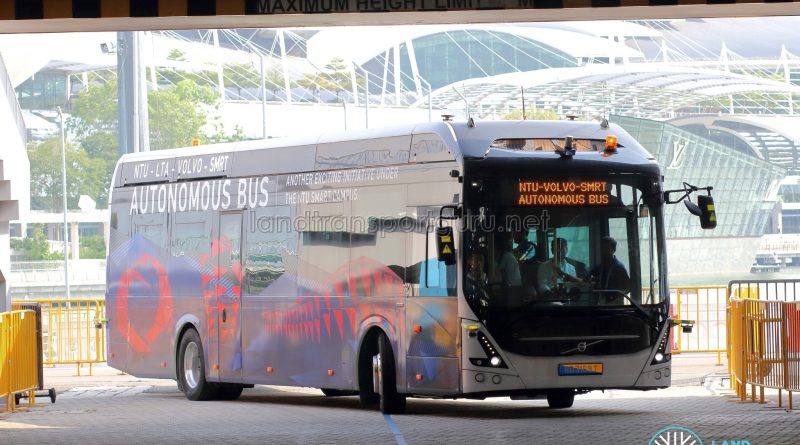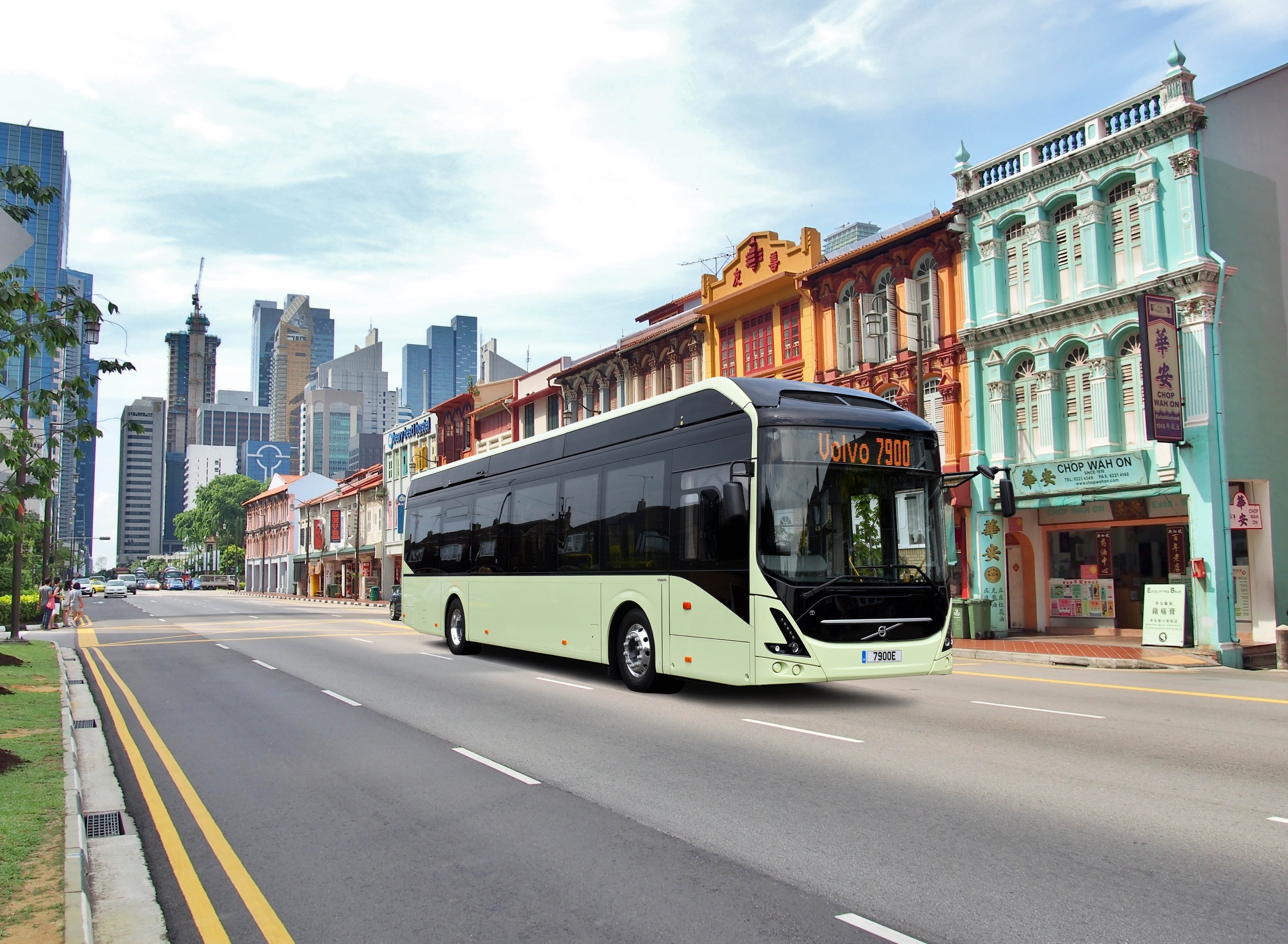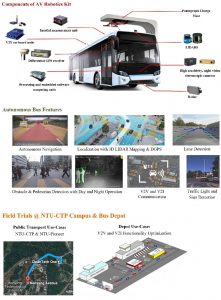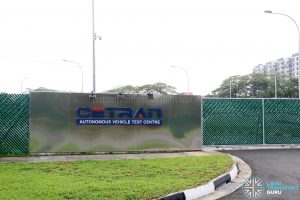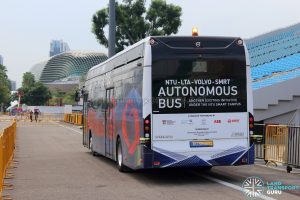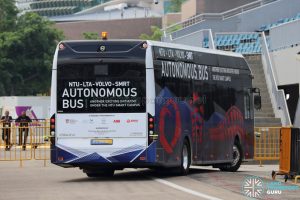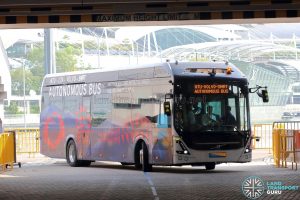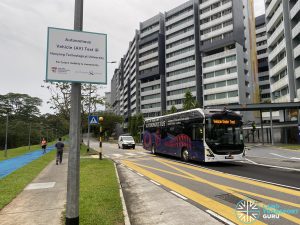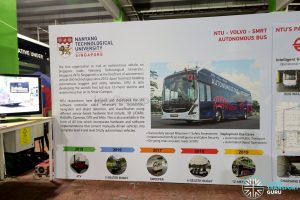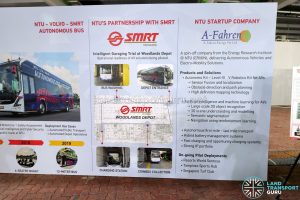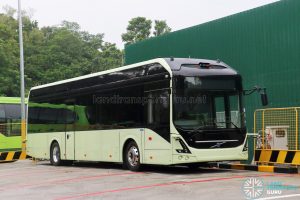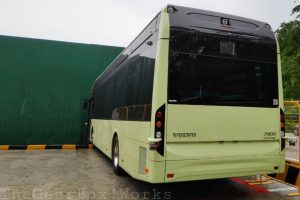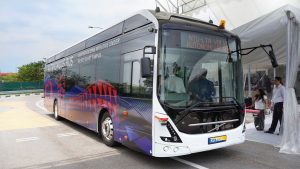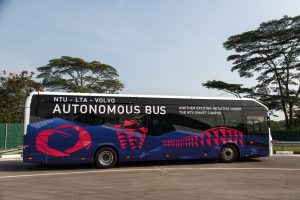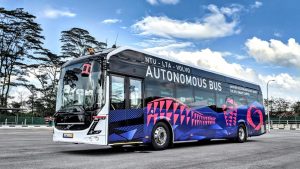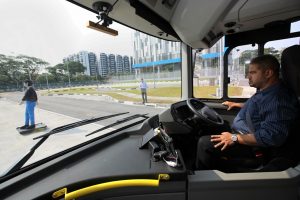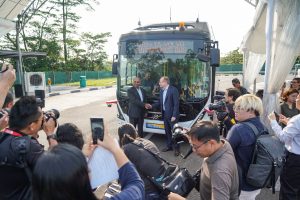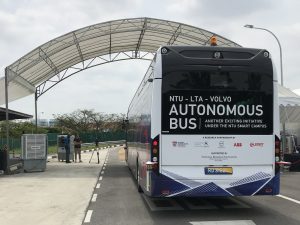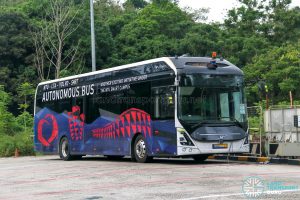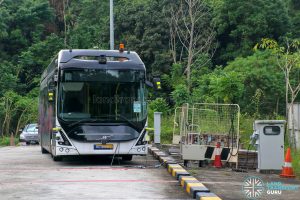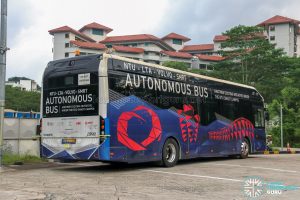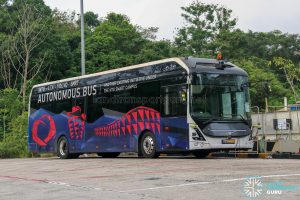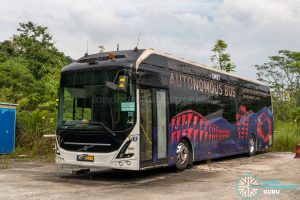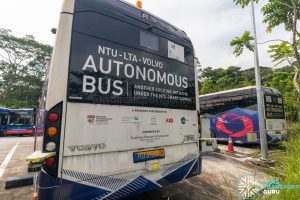The NTU-LTA-Volvo Autonomous Bus was launched on 5th March 2019. Touted as the first full-sized autonomous electric bus in the world, the 12-metre Volvo 7900 Electric bus was jointly developed by Volvo Buses of Sweden, in partnership with the Nanyang Technological University (NTU) and Singapore’s Land Transport Authority (LTA), with a goal of conducting autonomous vehicle bus trials for fixed routes and scheduled services.
Two such Volvo autonomous buses were brought into Singapore for research and development efforts, registered RD3162L and RD3169T. As of 2022, the buses have demonstrated SAE Level 3 autonomous driving, where most driving tasks can be performed autonomously, but human override is still required in some cases.
At a glance
The NTU-LTA-Volvo autonomous bus is built on the Volvo 7900 Electric bus, an existing electric city bus already being sold in the European market. Autonomous hardware on the bus includes LIDAR sensors, stereo-vision cameras and GNSS receivers. Sensor fusion is facilitated by what is claimed to be a ‘comprehensive artificial intelligence (AI) system developed by ERI@N’, with industry-leading cybersecurity measures.
Testing of the autonomous bus took place at two main sites. One bus would mainly be based at the NTU campus and CETRAN, a dedicated autonomous vehicle (AV) testing circuit. The other would be tested at SMRT’s Woodlands Bus Depot, an operational bus depot used to assess the vehicle’s ability to autonomously navigate in challenging conditions. These initiatives were aimed to verify the real-world performance of these vehicles ahead of a potential wider rollout.
Since 2022, updates on the project have been limited, and it is not known if regular trials are still being conducted. As of 2023, both buses appear to be in poor condition, and autonomous driving sensors have been removed from RD3162L.
The Bus
Main article: Volvo 7900 Electric
The Volvo 7900 Electric bus is used for the autonomous bus development trial. It is a fully-low-floor, single-deck, battery-electric city bus built by Volvo Buses for the European market, and requires 80 per cent less energy than an equivalent-sized diesel bus.
The bus was first unveiled in October 2015 and entered service in Europe prior to the autonomous bus project in Singapore. The bus uses the OppCharge opportunity charging standard, where the batteries are charged rapidly via an overhead pantograph. Conventional plug-in charging as a backup option is also offered.
For the trial, the two Volvo 7900 Electric buses are configured in a 12-metre right-hand drive (RHD). RD3162L comes with a single entrance door, while RD3169T comes with both an entrance and an exit door.
In support of this trial, the ABB HVC 300P fast charge system was installed at Cleantech One and Woodlands Bus Depot. These overhead chargers deliver 300 kW DC power and can recharge the bus’ battery in three to six minutes.
Autonomous Technology
Each autonomous bus is equipped with numerous sensors and navigation controls, such as light detection and ranging (LIDAR) sensors for charting, positioning and scanning the area around the bus; stereo-vision cameras that capture images in 3D; and an advanced global navigation satellite system which uses multiple data sources to give location accuracy of up to 1cm. The bus will also automatically regulate its steering, gear changing and speed.
In addition, the sensors and navigation platforms are managed by an artificial intelligence (AI) system developed by NTU researchers, which also enables the vehicle to navigate autonomously through dense traffic and tropical weather conditions. It is also protected with cybersecurity measures to prevent unwanted cyber intrusions.
Bus Features:
The buses bear the registration numbers RD3162L and RD3169T.
| Basic Technical Specifications | |
| Motor / Battery | Electric Motor paired with Lithium-Ion batteries Electric motor rated at 160 kW / 400 Nm |
| Transmission | Volvo 2-speed automated transmission |
| Bodywork | Volvo Integral Bodywork (TBC) Assembled in Wroclaw, Poland and shipped to Singapore fully assembled |
| Autonomous Technology | – LIDAR sensors (Light detection and ranging) for charting, positioning and scanning areas around the bus – Stereo-vision cameras for 3D image capture – Advanced Global Navigation Satellite System for location accuracy of up to 1 cm – Autonomous controller and monitoring station — automatically-regulated steering, gear changing and speed control – Artificial Intelligence (AI) system for navigation – Cybersecurity measures to prevent unwanted cyber intrusions |
| Other Equipment | – Mobitec Electronic Display Sign (EDS) — Orange LED matrix design, mounted on front, side and rear – Autonomous driving activation button and emergency cutoff next to dashboard – Driver display screen for autonomous software interface – Rooftop charging rails for inverted pantograph charging – Valeo REVO-E electric air-conditioning system – Manual wheelchair ramp – Hopper windows – Emergency exit door (offside) – USB charging ports – Rotating beacon light (front and rear) – Licensed carrying capacity (RD3162L): 36 seated and 57 standing passengers |
Investment:
According to Volvo Buses president Hakan Agnevall in March 2019, the company had invested $4 million so far in the trials, with the additional amount spent on technology development on the bus “much, much more” than $4 million. He added that Volvo would continue investing in Singapore, despite having spent significant amounts on the autonomous bus development project.
Development Timeline:
Detailed development timeline (Click to expand)June 2015 – Request for Information
In June 2015, the Land Transport Authority (LTA) issued a Request for Information (RFI) (RFI-PR132 – Request for Information – Singapore Autonomous Vehicle Initiative (SAVI)@One-North) to seek “proposals on how AV technology can be harnessed as part of other land transport mobility concepts, which include mobility-on-demand and autonomous buses”.
October 2016 – Agreement for Autonomous Bus Trials between LTA & NTU
On 19 October 2016, an agreement between LTA and Nanyang Technological University (NTU Singapore) was signed during the opening ceremony of the Singapore International Transport Congress and Exhibition (SITCE) 2016 to collaborate on a series of transport research projects, conducted under the ambit of the LTA-NTU Transport Research Centre (TRC) which was set up in November 2015 to conduct research and technical trials for innovative technologies in the transport industry. One of the projects involved trials for two fully-autonomous 12-metre buses.
For the Autonomous Bus Trial, as part of the RFI issued in June 2015, LTA partnered the Energy Research Institute @ NTU (ERI@N) to develop autonomous bus technologies, which included conducting a self-driving bus trial for fixed and scheduled services for intra- and inter-town travel.
Under the collaboration, ERI@N will test and develop its self-driving vehicle technology with two electric hybrid buses. ERI@N aims to outfit existing buses with a suite of intelligent sensors and develop an autonomous system that can effectively navigate Singapore’s local road traffic and climate conditions, enabling self-driving buses to operate safely and efficiently.
The roads between NTU and CleanTech Park, which is located within Jurong Innovation District, have been earmarked as potential test routes for the self-driving bus trial. It is envisaged that the trial could be extended in future to ferry commuters from NTU and Cleantech Park to Pioneer MRT station.
The self-driving buses will feature opportunistic charging technology that will enable them to be recharged when they stop at a bus depot or bus stops.
January 2018 – Volvo 7900 Electric Bus chosen for Trial
On 11 January 2018, NTU Singapore and Volvo Buses announced that they would begin testing autonomous electric passenger buses in Singapore in 2019, using the 40-seater Volvo 7900 Electric buses equipped with autonomous driving technologies. These technologies include GPS and LIDAR laser technology systems for charting, positioning and detecting obstacles around the vehicle, and an integrated navigation system that includes automated steering, gear changing, and speed throttling technologies.
The buses will be tested from early 2019 at the Centre of Excellence for Testing and Research of Autonomous vehicles at NTU (CETRAN). The autonomous vehicle test circuit, which is modelled after real road conditions in Singapore, provides a safe and controlled environment to test autonomous vehicles.
The NTU-Volvo programme was supported by SMRT and ABB, which will be assessing the vehicles’ roadworthiness and charging systems.
March 2019 – Launch of Autonomous Electric Bus
On 5 March 2019, NTU Singapore and Volvo Buses launched Volvo 7900 Electric Autonomous Bus, touted as “the world’s first full size, autonomous electric bus today”.
The Nanyang Technological University (NTU) entered the Autonomous Bus scene in October 2016 when it signed an agreement with the LTA to develop autonomous bus technologies, including conducting a self-driving bus trial for fixed and scheduled services for intra- and inter-town travel.
Under this collaboration, the Energy Research Institute @ NTU (ERI@N) would test and develop their self-driving vehicle technology with two electric hybrid buses. The roads between NTU and CleanTech Park, which is located within Jurong Innovation District, were earmarked as potential test routes for the self-driving bus trial. It was envisaged that the trial could be extended in future to ferry commuters from NTU and Cleantech Park to Pioneer MRT station. The self-driving buses would feature opportunistic charging technology that will enable them to be recharged when they stop at a bus depot or bus stops.
In January 2018, Volvo Buses was brought on board the trial to develop electricity-powered autonomous buses, representing the company’s first foray into autonomous uses for buses and public transport. The project to develop the Autonomous Bus is led by the Nanyang Technological University (NTU)’s Centre of Excellence for Testing and Research of Autonomous Vehicles (CETRAN).
In March 2019, a launch ceremony and media event was held. Videos posted by the media show the bus stopping safely when it is presented with an obstacle in front; however, the bus ran through multiple red lights and failed to keep in lane while navigating a left turn.
October 2019 – ITS World Congress Singapore 2019
RD3169T was showcased at the 26th ITS World Congress 2019 held in Singapore. As part of the demonstrations, the autonomous bus ferried visitors along a fixed circuit within The Float @ Marina Bay.
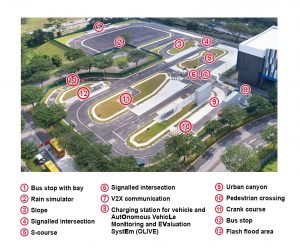
CETRAN test circuit
The bus was extensively tested at NTU’s Centre of Excellence for Testing and Research of Autonomous Vehicles (CETRAN), a 1.8-hectare test facility within the Jurong Innovation District. Opened in August 2016, the test circuit emulates a multitude of urban scenarios, including an area with simulated rainfall. The facility offers a safe environment for rigorous testing of the bus before it enters public roads.
RD3162L was extensively tested at CETRAN in early 2019 ahead of the bus’ official launch in March 2019.
NTU road trials
Mixed traffic demonstrations were planned for 2019 with RD3162L being tested on roads within the NTU campus. During the trials, the bus would be tested without passengers on board. There were plans to extend the test route between NTU and the nearby Pioneer MRT Station, but were not known to have materialised.
According to ERI@N, the NTU Route used for testing comprised one (1) roundabout, three (3) zebra crossings and five (5) bus stops, and one (1) traffic light signal in the junction with dynamic road objects. This presented challenges to the bus’ autonomous driving systems as there was a need to increase the efficiency and speed of image recognition. To achieve this, long and short-range cameras were deployed, together with a combination of ‘multiple framework’ (sic) to lessen the computational load and to achieve a better real-time performance.
SMRT Bus Depot Trial
The other autonomous bus, registered RD3169T, was trialled at SMRT Woodlands Bus Depot to test the vehicle’s capabilities to autonomously navigate around the tight confines of the bus depot.
As part of this trial, the bus was required to autonomously traverse a loop within the bus depot, visiting the coin deposit station, washing bay, and the parking/charging area. This route also involved demonstrating forward and reverse driving. An overhead pantograph charger was installed on the depot for this trial.
According to ERI@N, the concept of autonomous depot testing aims to relieve the driver from being onboard the bus as it manoeuvres through various crucial stations within the bus depot. Substantial time management and minimisation of error due to manual operations could be achieved by introducing autonomy for adept parking, manoeuvring, and obstacle detection. In addition, automating the cleaning and washing of buses could reduce driver exhaustion due to late shifts and increase productivity.
Disposal
By November 2025, at least 1 unit (RD3169T), was scrapped.
Gallery: (Before restickering)
Gallery: (Launch event)
Gallery: (Bus in 2021)
Gallery: (Bus in 2023)
See Also:
External Links & References:
- Joint News Release by the Land Transport Authority (LTA) & NTU – On the Road to a More Sustainable and Reliable Transport System – LTA
- Driverless electric buses to be tested from 2019 in collaboration between NTU, Volvo – Channel NewsAsia
- Volvo and NTU to trial electric buses in Singapore – Volvo Buses
- Volvo’s Autonomous electric buses in Singapore – Volvo Buses
- Driverless electric bus launched by NTU and Volvo in ‘world first’ – Channel NewsAsia
- World’s first full-sized, driverless electric bus launched by NTU and Volvo – TODAY
- NTU and Volvo launch world’s first full-sized driverless electric bus for trial – Straits Times
- NTU Singapore and Volvo unveil world’s first full size, autonomous electric bus – NTU
- ABB puts the charge into world’s first 12-metre fully electric autonomous bus – ABB
- ERI@N Annual Report 2021/2022
Back to Bus Models
Back to Bus Articles
